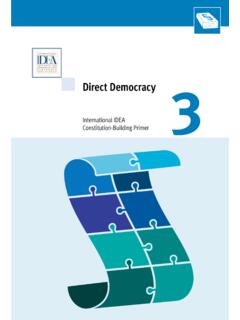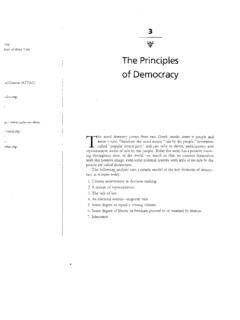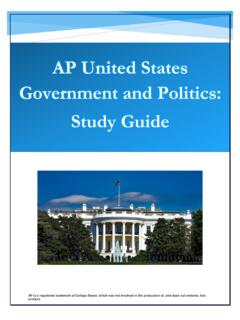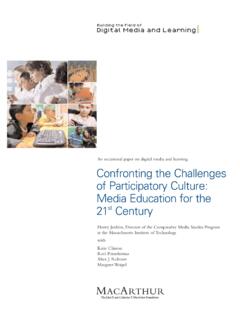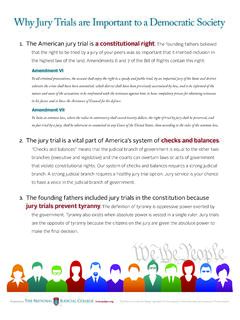Transcription of The Role of Media in Democracy: A Strategic Approach
1 CENTER FOR democracy AND GOVERNANCE ..promoting the transition to and consolidation of democratic regimes throughout the world. THE ROLE OF Media IN Democracy: A Strategic Approach June 1999 Technical Publication SeriesCenter for democracy and GovernanceBureau for Global Programs, Field Support, and Agency for International DevelopmentWashington, 20523-31002I. Defining Goals: The Role of Media in Mapping the Identifying Key Designing Media Programmatic Strategic Approach ChartRole of Media in democracy 1I. INTRODUCTIONA leading Palestinian journalist is jailed in theWest Bank for broadcasting sessions of thePalestinian Legislative Council. Restrictivemedia laws in many post-communist countriescurtail Media freedoms guaranteed by thesecountries' constitutions, or by internationalconventions that these countries have signed.
2 InCentral America, a select group of powerfulfamilies control the Media and threatendemocratic gains realized through the peaceprocesses of the 1990s. Government control ofprint and broadcast Media in many Africancountries leave little scope for dissenting opinionsand, therefore, public are the obstacles to Media freedom. Agency for International Development(USAID) and its partners have attempted toaddress these obstacles and to develop mediasectors around the globe that would contribute todemocracy. As such, support for Media is animportant prong of democracy andgovernance assistance. USAID s objective of theincreased development of a politically active civilsociety provides a Strategic rationale for Media -related activities. In addition, a desired result ofan enhanced free flow of information broadlystates the Agency's target for Media there is a significant range of activitieswhich could fall under the heading mediasupport, a distinction is made in this paperbetween those activities which might indirectlycontribute to Media development (such as civiceducation or communication campaigns in thehealth and education sectors), and those whichare directly targeted to strengthen the Media as aninstitution, specifically Media sector support.
3 Asthis Strategic Approach lays out, this Media sectorsupport extends beyond training and includesreforming Media laws, removing barriers toaccess, strengthening constituencies for reform,and capitalizing the , there have been few, if any, toolsavailable to USAID country missions and theirpartners to help them think strategically about therelationship between Media and society, and themost effective ways to strengthen the Media 'scontribution to democracy . Given this, somemissions have been hesitant to engage in mediasector support, even though they recognize theimportant role it plays in democratic transitionand consolidation. Other missions, daunted bythe difficulty of reporting results in this field,have decided not to undertake Media activities orto focus exclusively on training. Contextualfactors such as the lack of a legal enablingenvironment and political will within thegovernment, business, or civil society to supportmedia freedom all constrain missions' efforts inmedia sector majority of these Media activities has beencarried out in the Europe and New IndependentStates region (ENI), with another significantamount taking place in the Latin America and theCaribbean region (LAC).
4 Total USAID supportfor Media development ranges from equipmentprovision and journalist training to Media lawand policy addition there exist various USAID mechanisms to support Media sector developmentfrom the regional bureaus, field missions, and theOffice of Transition Initiatives (OTI) in theBureau of Humanitarian Response. For example,OTI programs have focused on the following: Supporting objective news and informationprograms, so that people can make informeddecisions and counter state-controlled Media Cultivating alternative Media , so thatmultiple voices and opinions will be heard Mobilizing popular participation in thetransition process Multiplying the impact of transition activitiesby disseminating information on successfullocal peace and participatory effortsWithin the Center for democracy andGovernance, technical assistance and field2 Role of Media in Democracysupport can be provided by Center staff, or byaccessing one of its civil society indefinitequantity contracts (IQCs).
5 The primary purposeof these IQCs is to provide rapid-responsetechnical assistance to support civil societyprograms (including Media ) of USAID missionsand regional government agencies have experiencein training Media professionals and carrying outexchanges. democracy officers should conferwith the Center as well as these other agencies, inparticular USIA, to ensure that our in-countryactivities are Strategic Approach presented in this paperoffers guidance to USAID missions, rather thanany blueprint, for making choices about whichmedia activities might be most appropriate in agiven context. In addition to suggesting a goal toguide USAID Media programs, the approachprovides examples of successful Media assistanceactivities and discusses factors influencing Section II, the role of Media in democracy isdefined and Media s place in USAID s strategicframework and international conventions isoutlined.
6 Section III addresses mapping the mediasector. Outside of the specific outlets that delivernews and information, what constitutes Media and its support? The principal questions used tohelp shape Media sector support strategies areidentified in Section IV. They are used todetermine who holds power to communicate in asociety, who has access to the means ofcommunication, and who is communicated V provides macro-level guidance on howto design Media Section VI this paper turns to anexamination of a Strategic Approach for the mediasector. Chief components of any strategy areshaping the legal enabling environment,strengthening constituencies for reform, removingbarriers to access, training, and supporting 1 For further details, see the User's Guide for theCenter for democracy and Governance, of Media . Best practices aredetailed for each of these A provides a list of partnerorganizations, web sites, and contact B suggests a methodology forconducting Media sector assessments, based onthe Center s Strategic Assessment C contains the text of the 1991 Windhoek Declaration.
7 This declaration guidesthe work of a USAID partner, the Media Instituteof Southern Africa (MISA).Role of Media in democracy 3II. DEFINING GOALS:THE ROLE OF MEDIAIN DEMOCRACYA ccess to information is essential to the health ofdemocracy for at least two reasons. First, itensures that citizens make responsible, informedchoices rather than acting out of ignorance ormisinformation. Second, information serves a checking function by ensuring that electedrepresentatives uphold their oaths of office andcarry out the wishes of those who elected some societies, an antagonistic relationshipbetween Media and government represents a vitaland healthy element of fully functioningdemocracies. In post-conflict or ethnicallyhomogenous societies such a conflictual, tension-ridden relationship may not be appropriate, butthe role of the press to disseminate information asa way of mediating between the state and allfacets of civil society remains for Media is a critical prong of and governance assistance.
8 USAIDS trategic Objective , Increased developmentof a politically active civil society, provides arationale for Media -related Result , Enhanced free flowof information, broadly states the Agency's goalfor Media Media is considered by USAID to be a partof the civil society arena, it is well known thatmedia overlaps other functional areas ofdemocracy and governance. For example,support for Media may yield results ingovernance activities, particularly those relatedto decentralization, anti-corruption, and citizenparticipation in the policy process. The rule oflaw may be further institutionalized by supportfor an independent Media that keeps a check onthe judiciary, reports on the courts, and promotesa legal enabling environment suitable for pressfreedom. Free and fair elections conductedthrough transparent processes require a mediasector which gives candidates equal access, andreports the relevant issues in a timely, conventions buttress USAID'smedia activities.
9 Most notably, Article 19 of the1948 Universal Declaration of Human Rightsstates, Everyone has the right to freedom ofopinion and expression; this right includesfreedom to hold opinions without interference andto seek, receive, and impart information and ideasthrough any Media and regardless of frontiers. Within the context of supporting democratictransitions, the goal of Media developmentgenerally should be to move the Media from onethat is directed or even overtly controlled bygovernment or private interests to one that ismore open and has a degree of editorialindependence that serves the public interest. Ifthe Media is to have any meaningful role indemocracy, then the ultimate goal of mediaassistance should be to develop a range of diversemediums and voices that are credible, and tocreate and strengthen a sector that promotes suchoutlets. Credible outlets enable citizens to haveaccess to information that they need to makeinformed decisions and to participate in Media sector supportive of democracy wouldbe one that has a degree of editorialindependence, is financially viable, has diverseand plural voices, and serves the public public interest is defined as representing aplurality of voices both through a greater numberof outlets and through the diversity of views andvoices reflected within one of Media in DemocracyIII.
10 Role of Media in democracy THESECTORS upporting Media as an institution requires anunderstanding of what constitutes the , the Media sector consists of somethingbeyond the specific outlets that deliver news andinformation. But is it so amorphous that itencompasses everything from the universities thattrain future journalists to the courts that protecttheir rights? One extremely useful attempt to mapout the Media sector comes from the USAID-funded Media Development Program (MDP) inRussia. Jointly designed and implemented by theRussian American Press and Information Center(RAPIC) and Internews/Moscow, MDP's goal is to speed the development of a commerciallyviable Media sector in Russia. The objectivesdevised to achieve this goal suggest a particularapproach to defining and supporting the sector: Help foster advocacy for Media withlegislative and regulatory bodies Increase flows of advertising revenues to theregions (decentralization) Increase access to and ownership ofproduction and distribution Increase investment and loan opportunitiesfor regional Media Increase horizontal ties among mediaprofessionals Expand educational and practical programsin electronic information gathering anddissemination Expand educational and practical programsin business, management, and technical skills Increase professional contacts andcollaboration between domestic and foreignmedia companies and institutions Protect key resources, such as film andarchive materials that document historicaldevelopments, outside news feeds, electronicinformation sources (such as Lexis-Nexis)





